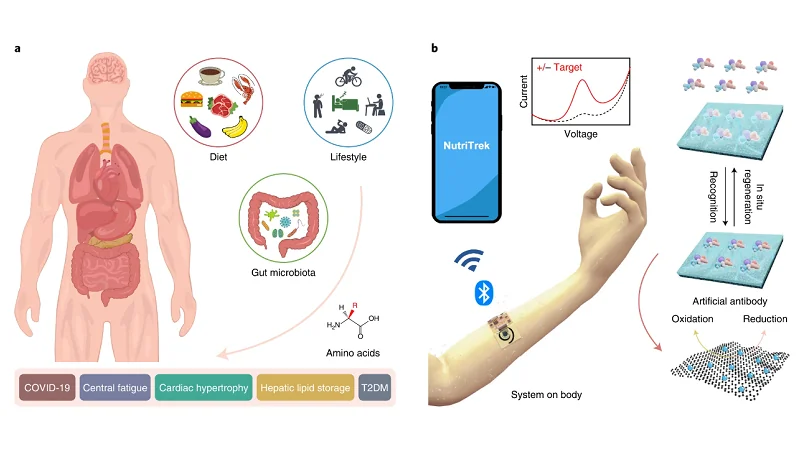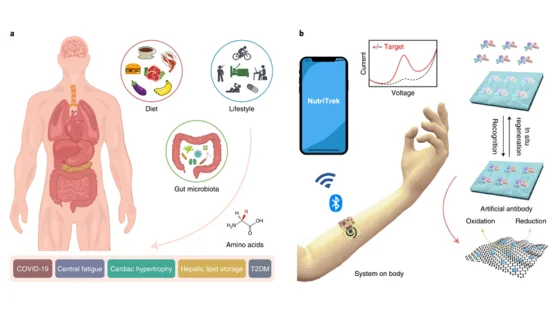Today, we want to highlight an interesting development on the wearable diagnostic front: researchers have developed a wearable device that can monitor nutrients, hormones, and drugs [1].
Real-time health monitoring
The popularity of medical wearables has increased in recent years. A few decades ago, a complex diagnostic machine able to measure circulating molecules in the blood would have been a large, intrusive, and bulky affair, but thanks to progress, such systems can be small and portable. This is greatly thanks to advances in processor technology and the ever-smaller sizes they are able to be produced in.
These researchers, based at Caltech’s Cherng Department of Medical Engineering, recently revealed this new device. They showcased how it could detect even trace amounts of nutrients and other molecules in human sweat. These nutrients and molecules can serve as useful biomarkers for determining human health in real time.
The technology behind the sensor was developed in the Wei Gao lab, which has been developing wearable technology like this for many years. This new, more precise device represents a new pinnacle of its work.
Perhaps the most interesting thing about the new sensor is that it uses molecularly imprinted polymers, which are shaped to work like artificial, reusable antibodies. This specially formed polymer is combined with a material that can be oxidized or reduced when an electrical voltage is applied when in contact with human sweat.
Finally, the device makes use of microfluidics, which uses many microscopic tubes less than a quarter of a millimeter wide to absorb tiny volumes of fluid. This lets the sensor monitor target molecules in sweat even when the amount of fluid available is miniscule.
The device has been tested by human participants in the lab setting with positive results. Dr. Gao hopes to test the device in larger-scale human studies as the next step.
Abstract
Wearable non-invasive biosensors for the continuous monitoring of metabolites in sweat can detect a few analytes at sufficiently high concentrations, typically during vigorous exercise so as to generate sufficient quantity of the biofluid. Here we report the design and performance of a wearable electrochemical biosensor for the continuous analysis, in sweat during physical exercise and at rest, of trace levels of multiple metabolites and nutrients, including all essential amino acids and vitamins. The biosensor consists of graphene electrodes that can be repeatedly regenerated in situ, functionalized with metabolite-specific antibody-like molecularly imprinted polymers and redox-active reporter nanoparticles, and integrated with modules for iontophoresis-based sweat induction, microfluidic sweat sampling, signal processing and calibration, and wireless communication. In volunteers, the biosensor enabled the real-time monitoring of the intake of amino acids and their levels during physical exercise, as well as the assessment of the risk of metabolic syndrome (by correlating amino acid levels in serum and sweat). The monitoring of metabolites for the early identification of abnormal health conditions could facilitate applications in precision nutrition.
Conclusion
Given that the device can potentially measure a wide range of nutrients, metabolites, hormones, and drugs, the utility here is obvious. Being able to monitor biological changes in real time could provide researchers with highly valuable information and help to inform follow-up studies.
Beyond clinical trials for aging interventions, such a technology could also prove popular in the public health wearables market. Imagine being able to monitor your nutrient intake and watch how things change in real time. It could also prove invaluable for people with conditions such as diabetes, helping them to optimize their glucose levels.
The ability to continuously monitor health biomarkers in real time has almost limitless applications, and this is an exciting development in diagnostics and biomarker monitoring.
Literature
[1] Wang, M., Yang, Y., Min, J., Song, Y., Tu, J., Mukasa, D., … & Gao, W. (2022). A wearable electrochemical biosensor for the monitoring of metabolites and nutrients. Nature Biomedical Engineering, 1-11.



